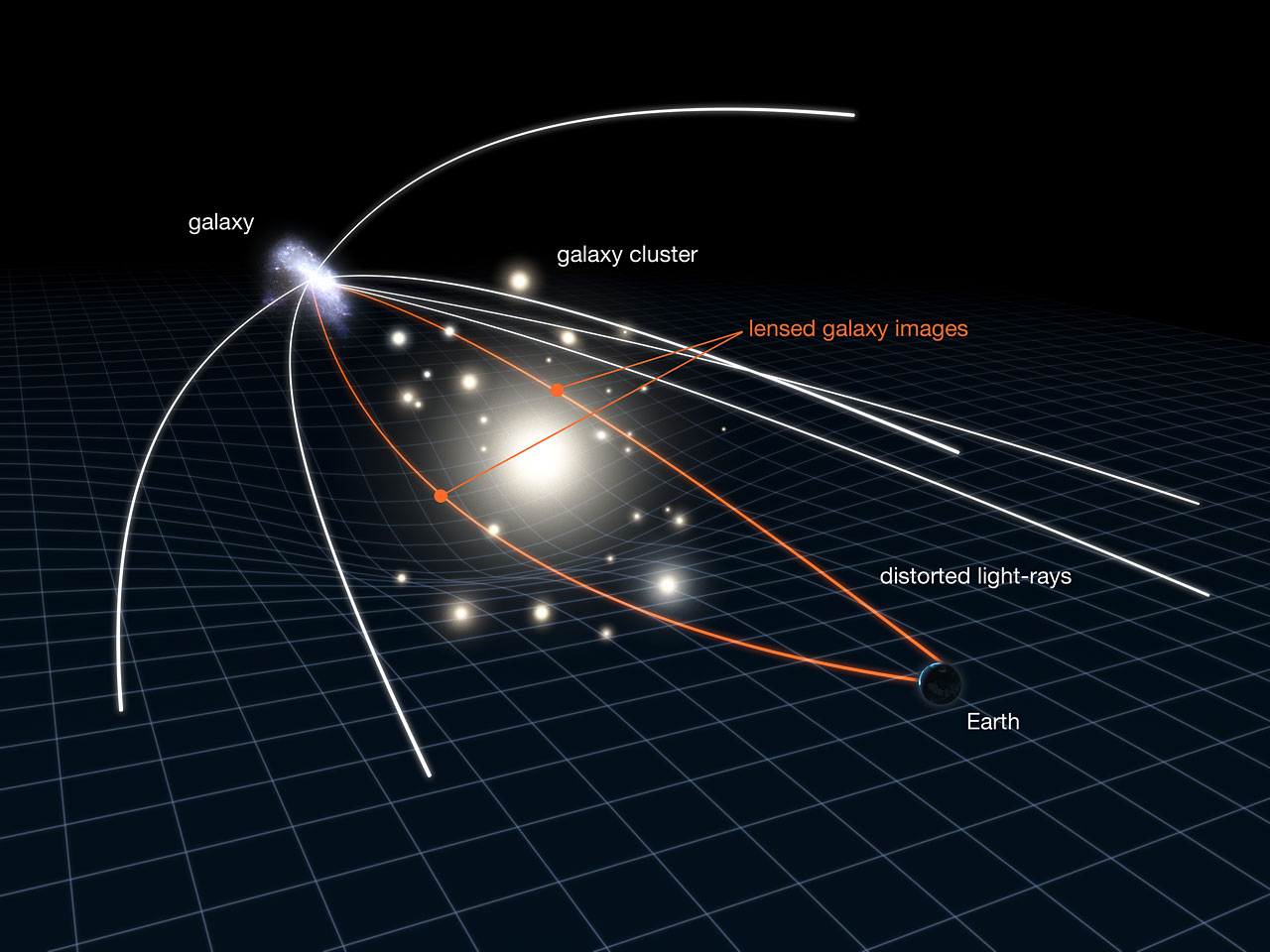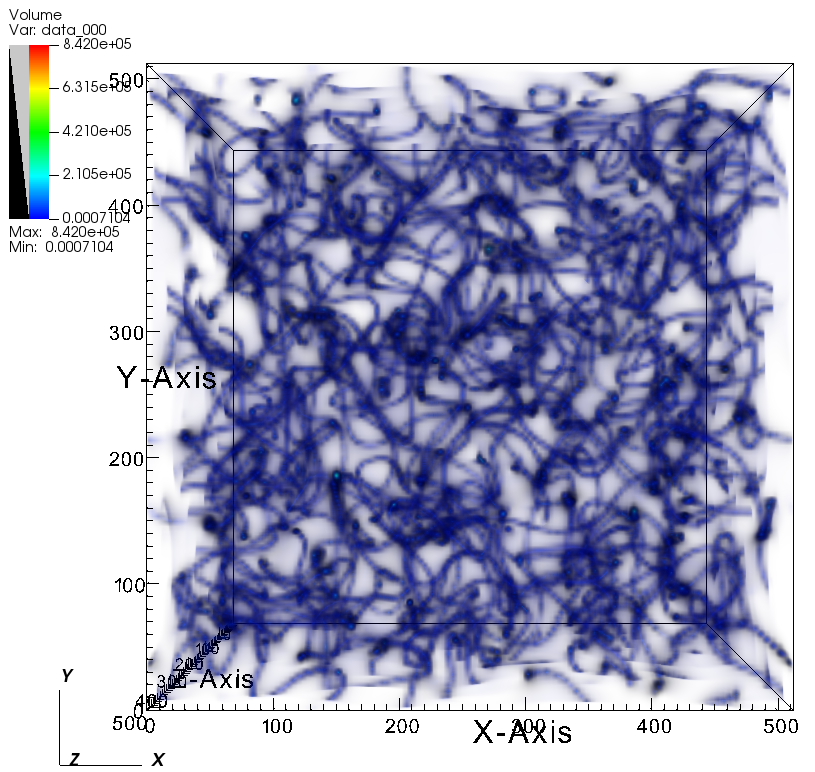Weak-lensing
Weak gravitational lensing is a phenomenon in astrophysics and cosmology that occurs when the path of light from distant objects, such as galaxies, is subtly curved by the gravitational influence of intervening matter, including dark matter and galaxy clusters. This effect results in the distortion and shearing of the images of these background objects. Unlike strong lensing, where the bending of light is so significant that it creates multiple distinct images, weak lensing induces subtle, coherent distortions in the shapes of background galaxies.

Weak lensing convergence maps play a crucial role in our understanding of the cosmos. These maps are generated by studying the distortion of light from distant galaxies as it passes through the gravitational influence of massive structures, such as galaxy clusters and dark matter concentrations. By measuring the apparent deformation of background galaxies, researchers construct weak lensing convergence maps that provide a unique window into the distribution of matter in the universe.
Higher-order statistics, like the wavelet \( \ell_1 \)-norm, are essential tools in the analysis of these maps. While traditional statistics focus on averages and two-point correlations, higher-order statistics capture more complex and nuanced information. In the case of weak lensing convergence maps, they enable us to explore non-Gaussian features and rare cosmic structures that might be overlooked by simpler statistics. These higher-order measures help uncover subtle yet significant deviations from theoretical expectations, shedding light on the intricate interplay between dark matter, dark energy, and the large-scale structure of the universe. In essence, they offer a deeper and more comprehensive understanding of the cosmic web and the fundamental forces shaping our universe.
In my research on weak lensing convergence maps, I focus on analyzing higher-order statistics, particularly the wavelet \( \ell_1 \)-norm. This statistical measure allows me to study the distribution of weak lensing convergence values across the observed map. To facilitate this analysis, I employ a theoretical model that describes the expected behavior of the convergence map, helping me draw meaningful conclusions and insights about the cosmic structures and gravitational lensing effects that influence these maps. By comparing the theoretical model to observed data, I aim to uncover valuable information about the large-scale structure of the universe and the nature of dark matter and dark energy.
Topological Defects
Topological defects are fascinating cosmic phenomena that emerge during phase transitions in the early universe. They arise as a result of field configurations that cannot be continuously deformed into a trivial state, leading to the formation of topologically stable structures. One notable characteristic of topological defects is their persistence throughout cosmic history, effectively acting as active perturbation seeds that can influence the evolution of the universe.
In a typical cosmological scenario, vector modes, which represent the direction of physical quantities, tend to decay rapidly and have minimal impact on the overall structure formation process. However, what sets topological defects apart is their ability to generate vector and tensor modes with magnitudes comparable to scalar modes during their formation. This unique feature has far-reaching implications for the large-scale structure of the universe.

The generation of vector and tensor modes by topological defects introduces anisotropic terms into the equations governing the evolution of the universe. These anisotropic terms can manifest as distinctive signatures in the cosmic structure. To understand and study the specific impact of topological defects on structure formation, it becomes essential to employ advanced tools such as relativistic N-body simulations. These simulations provide a comprehensive framework for modeling the complex interplay between topological defects and the evolving universe, allowing scientists to explore the consequences of these defects on the cosmic web and gain valuable insights into the fundamental forces shaping our cosmos. In essence, the study of topological defects adds a unique and intriguing dimension to our understanding of the universe's large-scale structure and its origins.
Large-Deviation Theory in Cosmology
Large-Deviation Theory (LDT) provides a powerful framework for studying the probabilities of rare events in complex systems. In cosmology, LDT plays a crucial role in understanding the evolution of the large-scale structure of the universe by enabling the derivation of theoretical predictions from first principles, without relying heavily on computationally expensive N-body simulations. LDT is particularly suited for analyzing non-Gaussian features and extreme cosmic structures that standard perturbation theories often struggle to describe.
In the context of cosmic structure formation, the initial density fluctuations in the universe are well approximated by a Gaussian random field. However, as the universe evolves under gravitational instability, these fluctuations become non-Gaussian due to non-linear processes such as the gravitational collapse of matter. LDT provides a systematic way to track this transition by focusing on the rate functions that describe the exponential decay of the probability distributions associated with large fluctuations. These rate functions encapsulate essential information about the likelihood of rare cosmic structures and the non-linear dynamics that govern their formation.
In my research, I build upon previous work and leverage LDT to derive a theoretical prediction for the wavelet \( \ell_1 \)-norm of weak lensing convergence maps. The key idea is to start from the Gaussian initial conditions, where the corresponding rate function is well understood. By incorporating the spherical collapse model, which describes the non-linear gravitational evolution of spherical overdense regions, I translate this initial Gaussian rate function into its late-time counterpart. This approach captures the essential non-linear effects in structure formation, providing a robust theoretical prediction for the late-time distribution of the convergence map.
The spherical collapse model serves as the backbone of this analysis, as it provides a direct and physically motivated mapping between the initial and final density fields. By combining this model with LDT, I obtain the late-time rate function that characterizes the probability of observing certain density configurations in the evolved universe. This prediction, in turn, allows for the theoretical determination of the wavelet \( \ell_1 \)-norm, a higher-order statistic that effectively captures the non-Gaussian features in weak lensing convergence maps.
My approach, grounded in first principles, offers a computationally efficient alternative to large-scale simulations, while still capturing the complex non-linear dynamics of cosmic structure formation. By comparing the theoretical predictions derived from LDT with observed data, I aim to provide deeper insights into the distribution of matter in the universe, the nature of dark matter and dark energy, and the intricate web of cosmic structures that shape our universe.